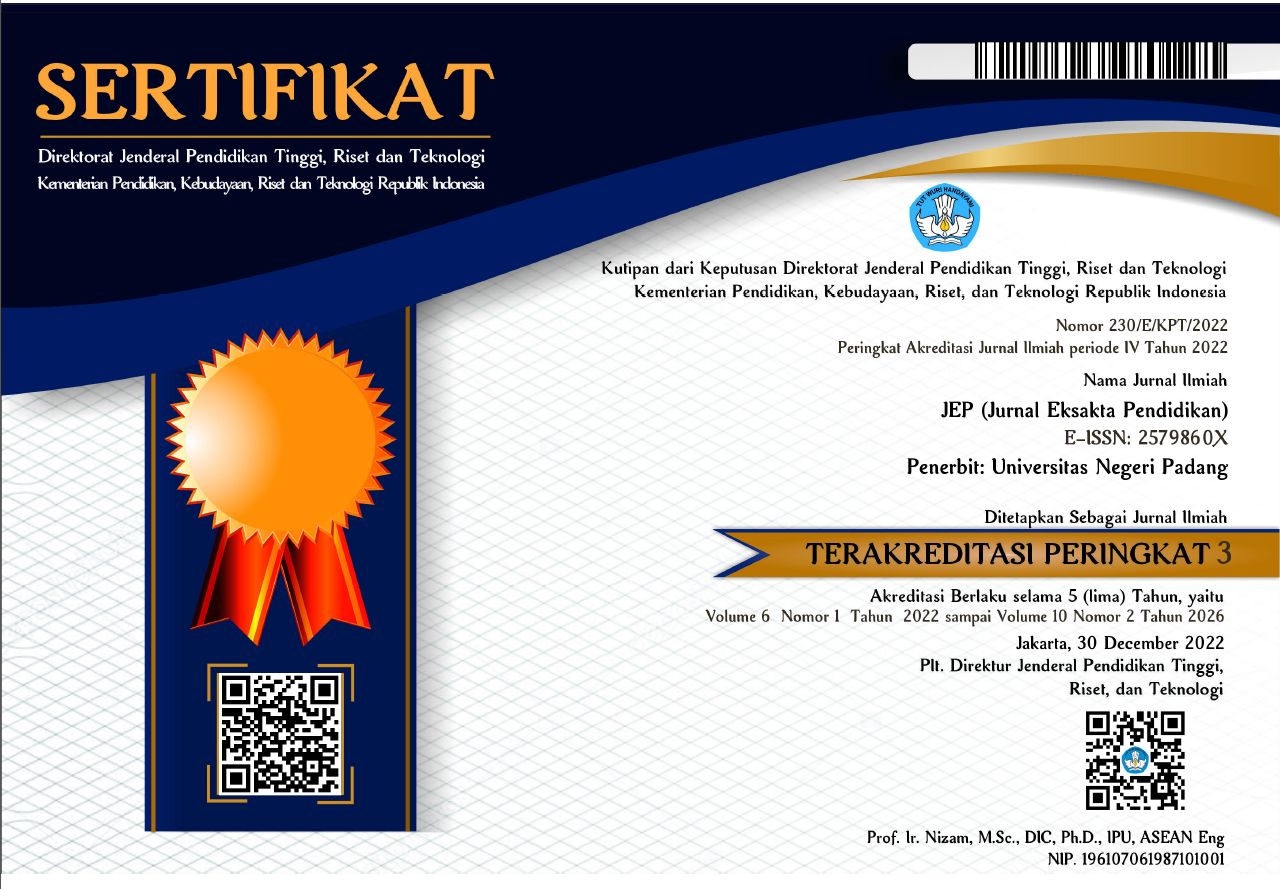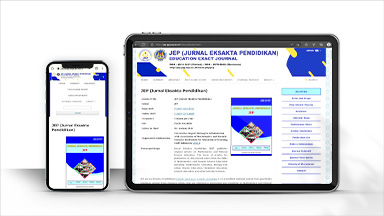Pengembangan Modul Konsep Mol Berbasis Inkuiri Terstruktur dengan Penekanan Pada Interkoneksi Tiga Level Representasi Kimia Untuk Kelas X SMA
Abstract
The research has created the module of mole concept based on structured inquiry with interconnection of multiple representation and determined the validity and practicality of the module. The research type was Research and Development (R&D). The development model was 4-D models that consist of four steps: define, design, develop, and disseminate. The research was limited on develop step. The instrument of the research was questionnaire form that consist of validity and practicality sheets. The module was validated by 5 validators. Practicality module was tested by 2 chemistry teachers and 28 students of grade XI MIA 5 at SMAN 4 of Padang. Validity and practicality data were analysed by using the kappa Cohen formula. The moment kappa average of 5 validators was 0,95 with highest validity category. The moment kappa average of teachers and students were 0,89 and 0,91 praticality with high category. The result of the research showed that the module of mole concept based on structured inquiry with interconnection of macro, submicro, and symbolic representation was valid and practice to be used on the learning chemistry
Downloads
References
Arikunto, S. 2008. Dasar-Dasar Evaluasi Pendidikan. Jakarta: Bumi Aksara.
Arinigsih, Ismi, dkk. 2014. “Pengembangan Panduan Praktikum Kimia Berbasis Inkuiri Terstruktur di Kelas XII SMAN 1 Indralaya Utara”. Program Studi Pendidikan Kimia, FKIP, Universitas Sriwijaya.
Bell, Randy. L, dkk. 2005. Simplifying Inquiry Instruction. The Science Teacher.
Boslaugh, Sarah dan Paul A. W. 2008. Statistics in a Nutshell, a desktop quick reference. Beijing, Cambridge, Famham, Köln, Sebastopol, Taipei,Tokyo: O’reilly.
Budiningsih, Asri. 2012. Belajar & Pembelajaran. Jakarta: PT Rineka Cipta.
Brady, James E. 2012. Chemistry The Molecular Nature of Matter. New York: John Wiley & Sons, Inc.
Chittleborough, G., Treagust, D. F., Mocerino, M. 2002. Constraints to the Development of FirtsYear University Chemistry Students’ Mental Model of Chemical Phenomena. Presented at the 11th Annual Teaching and Learning Forum for Western Australian Universities, Edith Cowan Universty, Australia.
Colburn, Alan. 2000. An inquiry Primer. Science Scope, Maret 2000.
Daryanto. 2014. Pengembangan Perangkat Pembelajaran. Yogyakarta: PT Gava Media.
Depdiknas. 2008. Panduan Pengembangan Bahan Ajar. Direktorat Jendral Manajemen Pendidikan Dasar dan Menengah, Tahun 2008.
Gilbert, John K dan David F.Treagust. 2009. Introduction: Macro, Submicro, and Symbolic Representations and the Relationship Between Them: Key Model in Chemical Education. Springer Science+Business Media.
Halim N. D. A., Ali Moh. B., Yahaya N., Said Mohd. N. H. M S. 2013. Mental Model in Learning Chemical Bonding: A preliminary study, Procedia-Social and Behavioral Sciences 97, Hal. 224-228.
Hamdani. 2010. Strategi Belajar Mengajar. Bandung: Pustaka Setia.
Kurniasih, Imas dan Berlin Sani. 2014. Sukses Mengimplementasikan Kurikulum 2013. Yogyakarta: Kata Pena.
Maryati, Anita Mariana. 2015. “Lembar Kerja (LKS) Eksperimen dan Non-Eksperimen Berbasis Inkuiri Terstruktur yang dikembangkan pada Subpokok Materi Pergeseran Kesetimbangan Kimia”. Prosiding Simposium Inovasi dan Pembelajaran Sains 2015.
Sabri, Ahmad. 2010. Strategi Belajar Mengajar. Bandung: Ciputat Press.
Schmid, Sarah and Franz X. Bogner. 2015. Effect of Students’ Effort Scores in a Structured Inquiry Unit on Long-Term Recall Abilities of Content Knowledge. Germany. Hindawi Publishing Corporation. Education Research International. Research Article.
Schnotz, Wolfgang and Maria Bannert. 2003. Construction and Interference in Learning from Multiple Representation. Elsevier Science Ltd.
Sugiarto. 2015. Peningkatan Hasil Belajar Materi Getaran dan Gelombang Melalui Pembelajaran Inkuiri Terstruktur. Didaktikum: Jurnal Penelitian Tindakan Kelas. Vol.16. No. 4.
Sugiyono. 2013. Metode Penelitian Kuantitatif Kualitatif dan R & D. Bandung: ALFABETA.
Sunyono. 2013. Efektifitas Model Pembelajaran Berbasis Multipel Representasi Dalam Membangun Model Mental Mahasiswa Topik Stoikiometri Reaksi. Jurnal Pendidikan Progresif . Vol.3. No. 1. Hlm. 65-79.
Trianto. 2014. Model Pembelajaran Terpadu. Jakarta: Bumi Aksara.
Yusus, Samsu dan Nani Sugandhi. 2011. Perkembangan Peserta Didik. Jakarta: PT Raja Grafindo Persada.
Zion, Michal dan Ruthy Mendelovici. 2012. Moving from Structured to Open Inquiry: Challenges and Limits. Science Education Internasional. Vol.23, No.4. Hlm. 383-399.

This work is licensed under a Creative Commons Attribution 4.0 International License.




_(2579-860X).png)
_(2614-1221)1.png)




